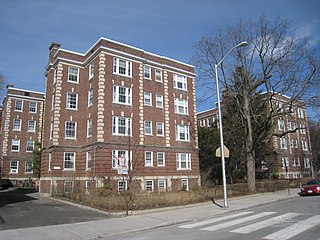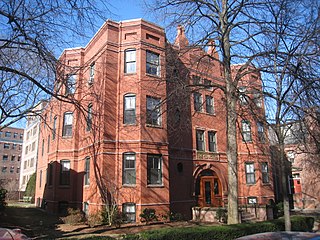
The Longfellow House–Washington's Headquarters National Historic Site is a historic site located at 105 Brattle Street in Cambridge, Massachusetts. It was the home of noted American poet Henry Wadsworth Longfellow for almost 50 years, and it had previously served as the headquarters of General George Washington (1775–76).

The George D. Birkhoff House is a historic house, at 22 Craigie Street, Cambridge, Massachusetts. It was designated a National Historic Landmark in 1975 for its association with Harvard University professor George David Birkhoff (1881–1944), one of the most important mathematicians of his time.

This is a list of sites listed on the National Register of Historic Places in Cambridge, Massachusetts. This is intended to be a complete list of the properties and districts on the National Register of Historic Places in Cambridge, Massachusetts, United States. Latitude and longitude coordinates are provided for many National Register properties and districts; these locations may be seen together in an online map.

The Berkeley Street Historic District is a historic district on Berkeley Street and Berkeley Place in Cambridge, Massachusetts. It encompasses a neighborhood containing one of the greatest concentrations of fine Italianate and Second Empire houses in the city. It was listed on the National Register of Historic Places in 1982, with a substantial increase in 1986.

The Cambridge Common Historic District is a historic district encompassing one of the oldest parts of Cambridge, Massachusetts. It is centered on the Cambridge Common, which was a center of civic activity in Cambridge after its founding in 1631. It was the site of the election for governor of the Massachusetts Bay Colony in 1636, and was a military barracks site during the American Revolutionary War. The common was gradually reduced in size to its present roughly triangular shape, and surrounded by buildings in the 18th and 19th centuries. In 1973 a historic district encompassing the extant common and everything within 100 feet (30 m) of it was listed on the National Register of Historic Places. In 1987 the district was amended to rationalize the boundary, which overlapped adjacent districts and included portions of some buildings.

The Dunvegan is an historic apartment building in Cambridge, Massachusetts. It was built in 1898 and added to the National Register of Historic Places in 1986.

The Ernst Flentje House is an historic house at 129 Magazine Street in Cambridge, Massachusetts. This three story wood frame apartment house exhibits the adaptive reuse of buildings. It was built in 1866 as a Second Empire single family residence with a mansard roof. In 1900 it was restyled by Ernst Flentje and converted into a three unit apartment house. It is one of the most exuberantly decorated triple deckers in the city.

The Richard Hapgood House is an historic multiunit house at 382-392 Harvard Street in Cambridge, Massachusetts. The six-unit wood-frame building was built in 1889, and represents an unusual instance of Queen Anne styling applied to such a large structure. It was built at a time when housing stock was transitioning from small types of multiunit housing to larger formats such as tenements and apartment houses.

The F. A. Kennedy Steam Bakery is a historic bakery at 129 Franklin Street in Cambridge, Massachusetts that first produced the Fig Newton in 1891.

The Jarvis is a historic apartment building at 27 Everett Street, on the north side of the Harvard University campus in Cambridge, Massachusetts. Built in 1890, the 4+1⁄2-story brick building was one of the first apartment houses built in the vicinity of northern Massachusetts Avenue. At the time, Massachusetts Avenue north of Harvard was predominantly lined with large fashionable houses. The Jarvis fit into this to some extent by being designed to resemble a large single family residence of the time. The building has irregular Queen Anne massing, polychrome trim, and massive corbelled end chimneys.

The Lechmere Point Corporation Houses is a historic apartment rowhouse at 45–51 Gore St. and 25 3rd Street in Cambridge, Massachusetts. Built sometime before 1821, this 2+1⁄2-story brick-and-wood structure is the only surviving building to be built by the Lechmere Point Corporation, which developed East Cambridge in the early decades of the 19th century. The house was owned for a time by lawyer and politician Christopher Gore, a principal of the corporation who also speculated in area real estate. Two of the buildings have retained their original gable roofs, while 49 Gore Street has been raised to a full three stories and given arched windows, and 51 Gore Street has had a mansard roof added.

The Lowell is an historic triple decker apartment house on 33 Lexington Avenue in Cambridge, Massachusetts. Built in 1900 to a design by local architect John Hasty, it is a rare multiunit building in the Brattle Street area outside Harvard Square. The Colonial Revival building has a swan's neck pediment above the center entry, which is echoed above the central second story windows. Doric pilasters separate the bays of the front facade, and the building distinctively has side porches, giving it added horizontal massing. It was built before the decision was made to locate the electrified trolleys on Mount Auburn Street instead of Brattle, a decision that reduced interest in building more multiunit housing in that area.

The Old Cambridge Historic District is a historic district encompassing a residential neighborhood of Cambridge, Massachusetts that dates to colonial times. It is located just west of Harvard Square, and includes all of the properties on Brattle Street west of Mason Street to Fresh Pond Parkway, all of the properties on Mason Street and Elmwood Avenue, and nearby properties on Craigie Street. The district includes five National Historic Landmarks: Elmwood, the Reginald A. Daly House, the Oliver Hastings House, the Mary Fiske Stoughton House, and the Longfellow House–Washington's Headquarters National Historic Site, as well as several other houses listed separately on the National Register. The district follows the general route of the Watertown Path, an early colonial road that supposedly followed a Native American trail. This portion of the way became known as Tory Row during the American Revolution, because many of the fine mansions lining it were owned by Loyalists. In the 19th and early 20th centuries it continued by a fashionable location, and now features a number of architecturally significant buildings. It includes 215 contributing buildings and one other contributing sites over an area of 52 acres (21 ha). One included building is the Cambridge Historical Society's offices, which are in the NRHP-listed Hooper-Lee Nichols House, located at 159 Brattle Street.

The Peabody Court Apartments are a historic apartment building at 41-43 Linnaean Street in Cambridge, Massachusetts. The four story Colonial Revival brick building was built in 1922. The H-shaped building has deep courtyards, and is trimmed with limestone elements, including corner quoins, window sills, and keystone lintels. It is a well-preserved example of a courtyard apartment block, a style popularized in 1898 by Ralph Adams Cram.

Ware Hall is an historic residential apartment building at 383 Harvard Street in Cambridge, Massachusetts. It was designed by local architect George Fogerty and built in 1893. Fogerty was also the architect of Claverly Hall, a similar building, on Mount Auburn Street. This five story brick Classical Revival building is a rare example of an apartment house built in Mid Cambridge that was designed to cater to Harvard University students. Apartment blocks of this quality were generally built closer to the Harvard campus, so this one stands out when compared to other apartment house in its immediate surroundings.

The Stanstead is a historic apartment building located at 19 Ware Street in Cambridge, Massachusetts. The three-story Richardsonian Romanesque building was built in 1887, and is an uncommon brick rendition of a triple=decker, more typically a wood-frame construction, that was just becoming popular in Cambridge. The architects, J. R. & W. P. Richards, also designed The Jarvis, another early brick apartment house in the city.

The Kingston Arms Apartments is an apartment building located at 296 East Grand Boulevard in Detroit, Michigan, in the East Grand Boulevard Historic District. It was listed on the National Register of Historic Places in 1999. The Kingston Arms, built in 1924, is a representative example of the rise of middle-class apartment buildings in pre-Depression era Detroit.

The Boynton and The Windsor are a pair historic buildings at 718 and 720 Main Street in Worcester, Massachusetts. They are nearly identical brick apartment buildings that were constructed c. 1887 to designs by Barker & Nourse, and are well preserved instances of late 19th century apartment house construction that once lined Main Street for many blocks. Of the two the Boynton is the better preserved, with an unaltered exterior.

Josephine Wright Chapman (1867–1943) was a pioneering woman architect, one of fewer than 100 practicing nationally in the first half of the 20th century. She was also the first woman architect "in the history of American architecture to start and head her very own firm," which she accomplished at the tail end of the 19th century. Practicing both in Boston and New York, she got her start as an apprentice in the prestigious Blackall, Clapp and Whittemore firm. Her first practice opened in 1897 in Grundmann Studios, a Boston-based women's art collective. A member of the New York Society of Architects, and one of only 70 female architects in the United States at the time, she was refused admission by both the American Institute of Architects and the Boston Architectural Club on the basis of her gender. Nonetheless, her repertoire soon included "churches, clubs, libraries, and apartments, as well as the Women’s Clubs in Lynn and Worcester, Massachusetts." Chapman's second practice was founded in New York, and that's when her career really took off,"[a]s confirmed by The Ladies’ Home Journal, which noted her popularity: “You can find her [Chapman’s] work everywhere in the environs of New York…”
The John Winthrop Chambers, also known historically as the Brooks Apartments, is a historic apartment house at 78-80 Porter Road in Cambridge, Massachusetts. The building was listed on the National Register of Historic Places in 2023. Built in 1915, it is a significant local example of residential Colonial Revival architecture, and an early example of the large courtyard-style apartment block in the Porter Square neighborhood of Cambridge. It was listed on the National Register of Historic Places in 2023.






















